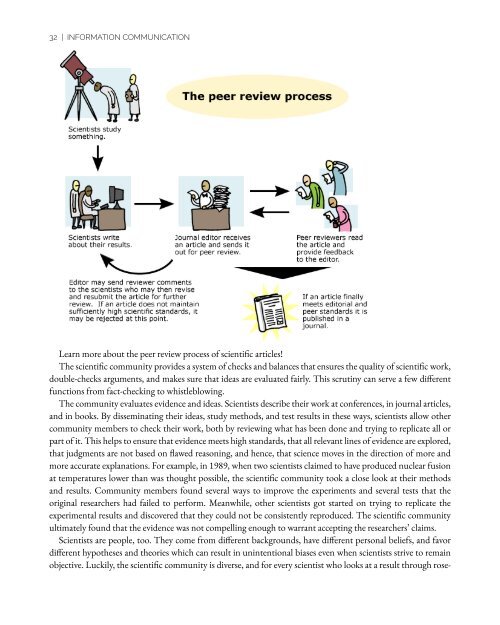An Interactive Introduction to Organismal and Molecular Biology, 2021
An Interactive Introduction to Organismal and Molecular Biology, 2021
An Interactive Introduction to Organismal and Molecular Biology, 2021
Create successful ePaper yourself
Turn your PDF publications into a flip-book with our unique Google optimized e-Paper software.
32 | INFORMATION COMMUNICATION<br />
Learn more about the peer review process of scientific articles!<br />
The scientific community provides a system of checks <strong>and</strong> balances that ensures the quality of scientific work,<br />
double-checks arguments, <strong>and</strong> makes sure that ideas are evaluated fairly. This scrutiny can serve a few different<br />
functions from fact-checking <strong>to</strong> whistleblowing.<br />
The community evaluates evidence <strong>and</strong> ideas. Scientists describe their work at conferences, in journal articles,<br />
<strong>and</strong> in books. By disseminating their ideas, study methods, <strong>and</strong> test results in these ways, scientists allow other<br />
community members <strong>to</strong> check their work, both by reviewing what has been done <strong>and</strong> trying <strong>to</strong> replicate all or<br />
part of it. This helps <strong>to</strong> ensure that evidence meets high st<strong>and</strong>ards, that all relevant lines of evidence are explored,<br />
that judgments are not based on flawed reasoning, <strong>and</strong> hence, that science moves in the direction of more <strong>and</strong><br />
more accurate explanations. For example, in 1989, when two scientists claimed <strong>to</strong> have produced nuclear fusion<br />
at temperatures lower than was thought possible, the scientific community <strong>to</strong>ok a close look at their methods<br />
<strong>and</strong> results. Community members found several ways <strong>to</strong> improve the experiments <strong>and</strong> several tests that the<br />
original researchers had failed <strong>to</strong> perform. Meanwhile, other scientists got started on trying <strong>to</strong> replicate the<br />
experimental results <strong>and</strong> discovered that they could not be consistently reproduced. The scientific community<br />
ultimately found that the evidence was not compelling enough <strong>to</strong> warrant accepting the researchers’ claims.<br />
Scientists are people, <strong>to</strong>o. They come from different backgrounds, have different personal beliefs, <strong>and</strong> favor<br />
different hypotheses <strong>and</strong> theories which can result in unintentional biases even when scientists strive <strong>to</strong> remain<br />
objective. Luckily, the scientific community is diverse, <strong>and</strong> for every scientist who looks at a result through rose-


















